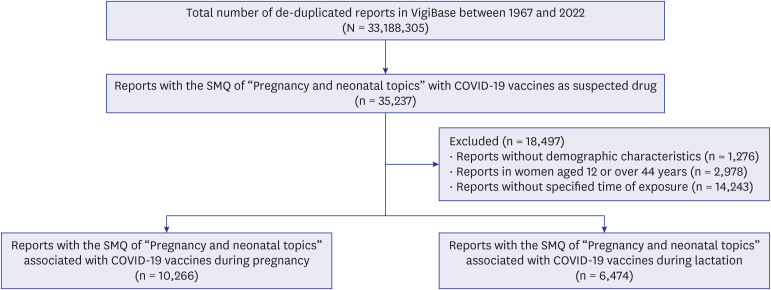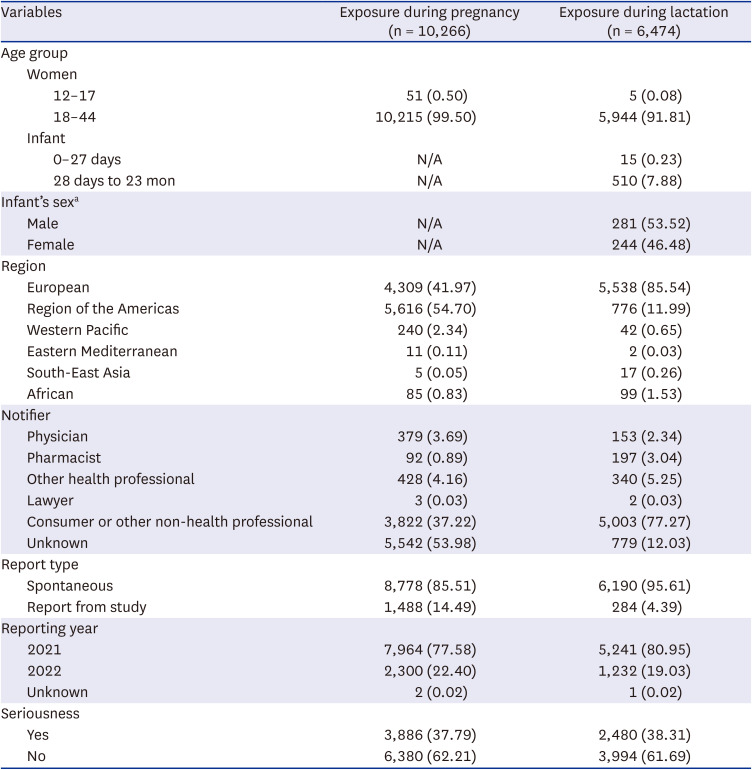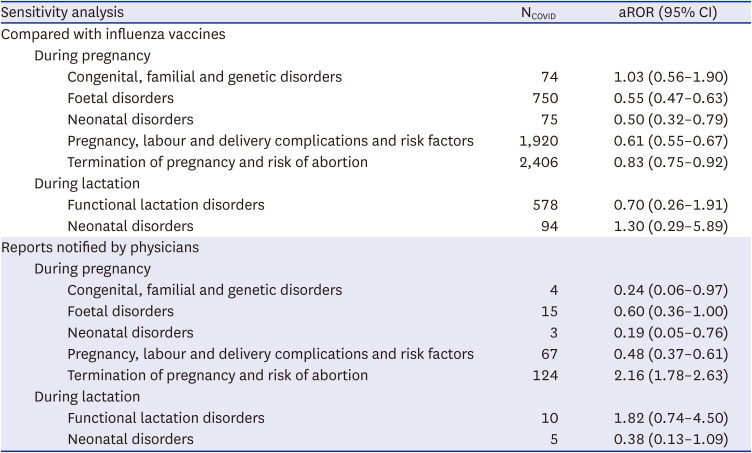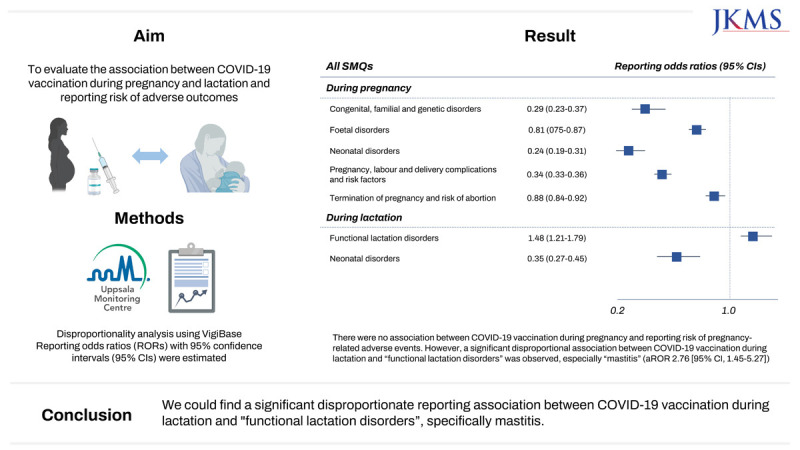3. Park WB, Hwang YH, Cheong HJ. COVID-19 vaccination in Korea. Infect Chemother. 2023; 55(1):135–149. PMID:
37021429.
4. Hong SH, Shi HJ, Kim SY, Park Y, Eom JS. Clinical characteristics and pregnancy-related outcomes of pregnant women hospitalized with COVID-19 during the delta wave: a single-center observational study. Infect Chemother. 2022; 54(3):433–445. PMID:
35920268.
5. Badell ML, Dude CM, Rasmussen SA, Jamieson DJ. COVID-19 vaccination in pregnancy. BMJ. 2022; 378:e069741. PMID:
35948352.
6. Ahn KH, Kim HI, Lee KS, Heo JS, Kim HY, Cho GJ, et al. COVID-19 and vaccination during pregnancy: a systematic analysis using Korea National Health Insurance claims data. Obstet Gynecol Sci. 2022; 65(6):487–501. PMID:
35916014.
7. Allotey J, Stallings E, Bonet M, Yap M, Chatterjee S, Kew T, et al. Clinical manifestations, risk factors, and maternal and perinatal outcomes of coronavirus disease 2019 in pregnancy: living systematic review and meta-analysis. BMJ. 2020; 370:m3320. PMID:
32873575.
8. Zeng H, Xu C, Fan J, Tang Y, Deng Q, Zhang W, et al. Antibodies in infants born to mothers with COVID-19 pneumonia. JAMA. 2020; 323(18):1848–1849. PMID:
32215589.
9. Zamaniyan M, Ebadi A, Aghajanpoor S, Rahmani Z, Haghshenas M, Azizi S. Preterm delivery, maternal death, and vertical transmission in a pregnant woman with COVID-19 infection. Prenat Diagn. 2020; 40(13):1759–1761. PMID:
32304114.
11. Kotlyar AM, Grechukhina O, Chen A, Popkhadze S, Grimshaw A, Tal O, et al. Vertical transmission of coronavirus disease 2019: a systematic review and meta-analysis. Am J Obstet Gynecol. 2021; 224(1):35–53.e3. PMID:
32739398.
12. Lee J, Lee MY, Lee J, Jang E, Bae S, Jung J, et al. Clinical characteristics and vertical transmission of severe acute respiratory syndrome coronavirus 2 infection in pregnant women and their neonates in Korea. Infect Chemother. 2023; 55(3):346–354. PMID:
37503777.
15. Shimabukuro TT, Kim SY, Myers TR, Moro PL, Oduyebo T, Panagiotakopoulos L, et al. Preliminary findings of mRNA COVID-19 vaccine safety in pregnant persons. N Engl J Med. 2021; 384(24):2273–2282. PMID:
33882218.
16. Magnus MC, Gjessing HK, Eide HN, Wilcox AJ, Fell DB, Håberg SE. COVID-19 vaccination during pregnancy and first-trimester miscarriage. N Engl J Med. 2021; 385(21):2008–2010. PMID:
34670062.
17. Kharbanda EO, Haapala J, DeSilva M, Vazquez-Benitez G, Vesco KK, Naleway AL, et al. Spontaneous abortion following COVID-19 vaccination during pregnancy. JAMA. 2021; 326(16):1629–1631. PMID:
34495304.
18. Rimmer MP, Teh JJ, Mackenzie SC, Al Wattar BH. The risk of miscarriage following COVID-19 vaccination: a systematic review and meta-analysis. Hum Reprod. 2023; 38(5):840–852. PMID:
36794918.
19. Lipkind HS, Vazquez-Benitez G, DeSilva M, Vesco KK, Ackerman-Banks C, Zhu J, et al. Receipt of COVID-19 vaccine during pregnancy and preterm or small-for-gestational-age at birth - eight integrated health care organizations, United States, December 15, 2020–July 22, 2021. MMWR Morb Mortal Wkly Rep. 2022; 71(1):26–30. PMID:
34990445.
20. Karasek D, Baer RJ, McLemore MR, Bell AJ, Blebu BE, Casey JA, et al. The association of COVID-19 infection in pregnancy with preterm birth: a retrospective cohort study in California. Lancet Reg Health Am. 2021; 2:100027. PMID:
34642685.
21. Muyldermans J, De Weerdt L, De Brabandere L, Maertens K, Tommelein E. The effects of COVID-19 vaccination on lactating women: a systematic review of the literature. Front Immunol. 2022; 13:852928. PMID:
35464406.
22. Hamid AAA, Rahim R, Teo SP. Pharmacovigilance and its importance for primary health care professionals. Korean J Fam Med. 2022; 43(5):290–295. PMID:
36168900.
27. Sperling RS, Riley LE. Immunization and Emerging Infections Expert Work Group. Influenza vaccination, pregnancy safety, and risk of early pregnancy loss. Obstet Gynecol. 2018; 131(5):799–802. PMID:
29630014.
30. Brady RC, Jackson LA, Frey SE, Shane AL, Walter EB, Swamy GK, et al. Randomized trial comparing the safety and antibody responses to live attenuated versus inactivated influenza vaccine when administered to breastfeeding women. Vaccine. 2018; 36(31):4663–4671. PMID:
29961606.
31. Yoon H, Choi BY, Seong WJ, Cho GJ, Na S, Jung YM, et al. COVID-19 vaccine acceptance during pregnancy and influencing factors in South Korea. J Clin Med. 2022; 11(19):5733. PMID:
36233601.
32. Blumberg D, Sridhar A, Lakshminrusimha S, Higgins RD, Saade G. COVID-19 vaccine considerations during pregnancy and lactation. Am J Perinatol. 2021; 38(6):523–528. PMID:
33932943.
33. Prasad S, Kalafat E, Blakeway H, Townsend R, O'Brien P, Morris E, et al. Systematic review and meta-analysis of the effectiveness and perinatal outcomes of COVID-19 vaccination in pregnancy. Nat Commun. 2022; 13(1):2414. PMID:
35538060.
34. Magnus MC, Örtqvist AK, Dahlqwist E, Ljung R, Skår F, Oakley L, et al. Association of SARS-CoV-2 vaccination during pregnancy with pregnancy outcomes. JAMA. 2022; 327(15):1469–1477. PMID:
35323851.
35. Fell DB, Dhinsa T, Alton GD, Török E, Dimanlig-Cruz S, Regan AK, et al. Association of COVID-19 vaccination in pregnancy with adverse peripartum outcomes. JAMA. 2022; 327(15):1478–1487. PMID:
35323842.
36. KCDC. Causality Assessment of Adverse Events Following COVID-19 Vaccination. Cheongju, Korea: KCDC;2021.
41. Kachikis A, Englund JA, Singleton M, Covelli I, Drake AL, Eckert LO. Short-term reactions among pregnant and lactating individuals in the first wave of the COVID-19 vaccine rollout. JAMA Netw Open. 2021; 4(8):e2121310. PMID:
34402893.
42. McLaurin-Jiang S, Garner CD, Krutsch K, Hale TW. Maternal and child symptoms following COVID-19 vaccination among breastfeeding mothers. Breastfeed Med. 2021; 16(9):702–709. PMID:
34171971.
43. Low JM, Lee LY, Ng YP, Zhong Y, Amin Z. Breastfeeding mother and child clinical outcomes after COVID-19 vaccination. J Hum Lact. 2022; 38(1):37–42. PMID:
34713745.
47. Goldshtein I, Nevo D, Steinberg DM, Rotem RS, Gorfine M, Chodick G, et al. Association between BNT162b2 vaccination and incidence of SARS-CoV-2 infection in pregnant women. JAMA. 2021; 326(8):728–735. PMID:
34251417.
48. Collier AY, McMahan K, Yu J, Tostanoski LH, Aguayo R, Ansel J, et al. Immunogenicity of COVID-19 mRNA vaccines in pregnant and lactating women. JAMA. 2021; 325(23):2370–2380. PMID:
33983379.
49. Montastruc JL, Sommet A, Bagheri H, Lapeyre-Mestre M. Benefits and strengths of the disproportionality analysis for identification of adverse drug reactions in a pharmacovigilance database. Br J Clin Pharmacol. 2011; 72(6):905–908. PMID:
21658092.









 PDF
PDF Citation
Citation Print
Print




 XML Download
XML Download